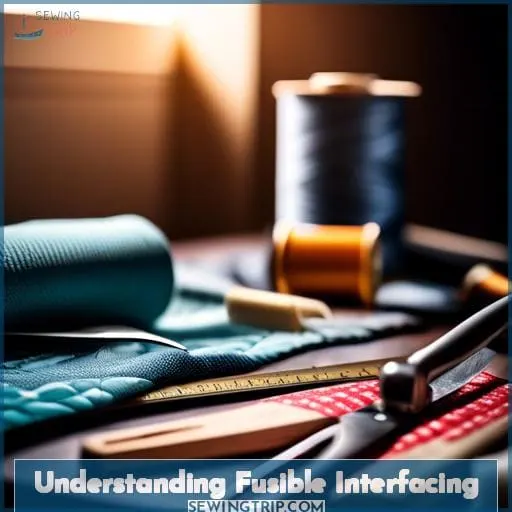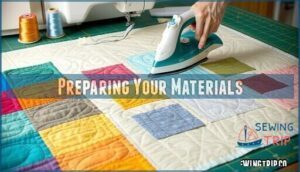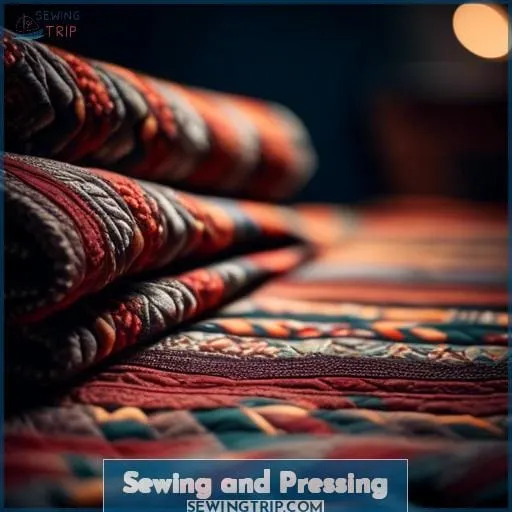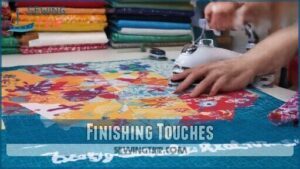This site is supported by our readers. We may earn a commission, at no cost to you, if you purchase through links.
1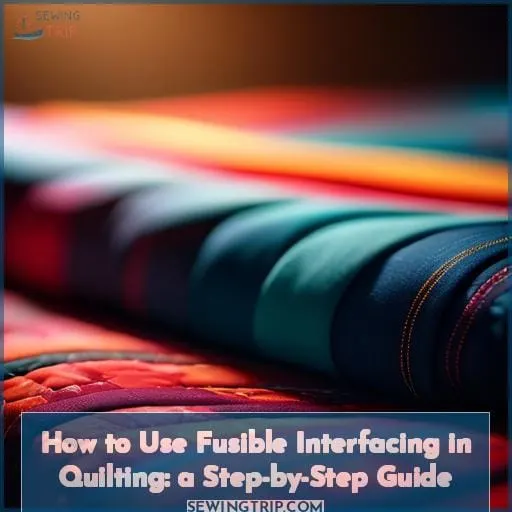 To introduce an article on How to Use Fusible Interfacing in Quilting: A Step-by-Step Guide, you can start by engaging the audience with a practical and experienced tone:
To introduce an article on How to Use Fusible Interfacing in Quilting: A Step-by-Step Guide, you can start by engaging the audience with a practical and experienced tone:
Embark on your quilting journey with confidence as you delve into the art of using fusible interfacing. Discover the secrets to enhancing your quilting projects with this step-by-step guide. From selecting the right interfacing to mastering the sewing and pressing techniques, unlock the potential of your quilting creations effortlessly.
Table Of Contents
Key Takeaways
- Fusible interfacing adds stability and precision to quilting projects, making it easier to sew pieces together and ensuring that the quilt maintains its shape over time.
- The weight of the fusible interfacing should complement the fabric’s movement; lighter interfacing is better for delicate fabrics, while heavier interfacing is suitable for sturdier fabrics.
- Pre-washing fusible interfacing is crucial to prevent shrinkage, and it should be cut and stored properly to ensure it’s ready for use in quilting projects.
- When finishing a quilt, fusible interfacing can be used to create a quilt sandwich, and it helps to hold the layers together, adding texture and ensuring the quilt is durable.
How to Use Fusible Interfacing for Quilting

To use fusible interfacing for quilting, first iron the interfacing to the wrong side of your fabric, then stitch around the edges to secure it in place. This method helps with precise applique work and stabilizes fabric for easier quilting.
Understanding Fusible Interfacing
Fusible interfacing can be a quilter’s ally, providing stability and precision to patchwork projects.
It comes in various types and weights, suitable for different fabric needs and quilting styles.
Benefits for Quilting
Fusible interfacing adds durability to your quilting projects, ensuring fabric compatibility and easing the sewing process.
When selecting interfacing, consider the thickness and prewash it to avoid shrinkage.
For best results, choose the right needle size for your sewing machine and fusible interfacing. The fusible quilter’s grid interfacing simplifies piecing, making your quilting journey a breeze.
Types and Weights
When quilting, choosing the right fusible interfacing is like picking the perfect dance partner—it needs to complement your fabric’s moves.
Interfacing weights vary from feather-light to heavy-duty, each setting the stage for your quilt’s performance. Opt for a lighter touch for delicate fabrics, while sturdier backings can handle a heavier mate.
Preparing Your Materials
Get ready to dive into the world of quilting by mastering the art of cutting fabric squares. This crucial step will set the foundation for a successful and enjoyable quilting experience.
Selecting the perfect interfacing for your project is equally important. By paying attention to this detail, you can ensure that your quilting journey is smooth and rewarding.
Cutting Fabric Squares
Cutting fabric squares is like setting the stage for a grand performance, where every actor must hit their mark. Think of your rotary cutter and cutting mat as the director and stage, respectively, guiding your fabric to stardom with precision.
Your fabric choice is the cast, each piece bringing its own flair to the ensemble. Square alignment and measurement accuracy are your script, ensuring that every scene flows seamlessly into the next.
The interfacing quality acts as the backdrop, supporting your actors without stealing the show. And let’s not forget the supporting roles: the wool pressing mat, which ensures every square is crisply pressed, and the coordinating thread, the binding that ties the entire performance together.
With these tools in hand, you’re ready to direct a masterpiece.
Selecting the Right Interfacing
When diving into the world of quilting, selecting the right interfacing is like picking the perfect spice for your dish—it can make all the difference.
Think of interfacing thickness as your fabric’s best buddy, offering just the right amount of support without stealing the show. Interfacing colors are more than just aesthetics; they ensure your quilt top shines without any unwanted surprises peeking through.
Before you marry your interfacing to your fabric, consider pre-washing to dodge any shrinkage drama. And when it comes to interfacing storage, treat it like your cherished quilt scraps—organized and accessible for that spur-of-the-moment quilt back or wall hanging project.
With a plethora of interfacing brands out there, it’s like being a kid in a candy store. But remember, whether you’re facing your quilt or crafting a quilt wall hanging, the right interfacing can turn a good project into a great one.
Sewing and Pressing
Once you’ve got your fabric and interfacing ready, it’s time to bring your quilt to life.
You’ll sew the columns and rows, then trim the seams and interfacing to ensure everything lays flat.
Column and Row Construction
When it comes to column and row construction in quilting, think of it as laying down the tracks for your creativity train.
- Column Alignment: Start by ensuring your columns are as straight as a dancer’s posture. This is where your interfacing placement shines, guiding each square into its spotlight.
- Row Alignment: Like a well-rehearsed chorus line, your rows need to be in harmony. Use the quilter’s fusible grid interfacing as your guide to keep everything in sync.
- Seam Allowance: Don’t skimp on the seam allowance; it’s the backstage crew that holds the show together. A consistent ¼ inch seam allowance ensures your masterpiece stays intact.
Seam and Interfacing Trimming
When it’s time to trim those seams and interfacing, think of it as giving your quilt a haircut.
Clip your interfacing at each intersection like you’re snipping away at split ends, careful not to nick the fabric’s seam. This step is like positioning your quilt for success, ensuring it lays flat and behaves.
If you’ve ever dealt with interfacing shrinkage, you know it can throw a wrench in your masterpiece. To avoid this, store your interfacing properly—think of it as tucking it into bed, so it’s fresh and ready for your next project.
And remember, there are plenty of interfacing alternatives out there. Like choosing between a latte and an espresso, it’s all about finding the right fit for your quilt’s personality.
Finishing Touches
Once your quilt top is assembled and pressed, it’s time to create the quilt sandwich.
You’ll layer your backing, batting, and quilt top, then baste them together to prepare for quilting.
After basting, you’ll quilt the layers, either by machine or hand, to add texture and ensure the quilt holds together through use and washing.
Binding is the final step, giving your quilt a finished edge and a polished look.
For a wall hanging, you might also add a facing or create tabs for hanging, providing a clean finish without the traditional binding look.
Creating a Quilt Sandwich
When it comes to sandwich preparation for your quilt, think of it as layering a scrumptious cake.
You’ll want to choose batting options that complement your quilt top, like picking the perfect filling.
For basting methods, it’s like adding just the right amount of frosting to hold everything together—spray, pin, or thread baste, your pick.
As you layer your quilt sandwich composition, ensure each layer is smooth and wrinkle-free.
Binding considerations are the cherry on top; they should secure and frame your masterpiece beautifully.
Quilting and Binding Options
When it comes to giving your quilt that final touch, you’re in for a treat. Let’s dive into the world of quilting and binding options, where your quilt’s personality shines through.
- Quilt Facing: For a sleek, modern edge, consider quilt facing. It’s like giving your quilt a secret handshake, hiding those raw edges without the bulk of traditional binding. Plus, it sets the stage for a clean finish that lets your design do the talking.
- Hanging Tabs: Want to show off your masterpiece? Add hanging tabs to the back. It’s like giving your quilt wings to fly on the wall. This method is perfect for quilts destined to be admired from afar, turning them into instant art pieces.
- Traditional Binding: Of course, there’s always the classic route. Traditional binding frames your quilt with a cozy border, like a hug that goes all the way around. It’s the time-honored way to say, I’m finished and ready to snuggle.
Whether you’re leaning towards the understated elegance of quilt facing, the practical charm of hanging tabs, or the comforting embrace of traditional binding, your quilt is about to step into the spotlight.
Frequently Asked Questions (FAQs)
Can fusible interfacing be reused for multiple projects?
No, fusible interfacing isn’t meant for multiple uses; once it’s fused to fabric, it’s a wrap.
Think of it as a one-hit wonder, giving its all to one project before retiring.
How does fabric type affect interfacing choice?
Choosing the right interfacing for your fabric is like picking the perfect dance partner; it’s all about finding that harmonious balance.
Lighter fabrics glide effortlessly with lightweight interfacing, while heavier materials demand a partner that can keep up, requiring sturdier interfacing.
It’s a dance of support, ensuring your project moves smoothly from concept to completion.
Is there a maximum thickness for fabric when using fusible interfacing?
There’s no strict maximum thickness for fabric with fusible interfacing. However, thicker fabrics can be trickier.
Can fusible interfacing be used with delicate fabrics like silk?
Yes, fusible interfacing can be used with delicate fabrics like silk. However, you’ll need to tread lightly.
It’s like walking on eggshells, but in the sewing room!
How does washing affect fusible interfacing’s adhesion over time?
Washing can play tricks on fusible interfacing’s stickiness, sometimes making it cling like a stubborn burr.
Regular laundering might gradually weaken its grip, leading to a game of peek-a-boo with your fabric.
Conclusion
As your quilting adventure unfolds, remember that mastering how to use fusible interfacing is like painting with fabric—each piece a stroke of creativity and precision.
You’ve learned to select, cut, and apply interfacing, transforming your quilts into masterpieces with depth and durability.
Embrace this technique, allowing it to guide your hands and imagination. Let your quilts tell stories, draped in the warmth of your artistic spirit.
With fusible interfacing as your ally, the possibilities in quilting are as boundless as your creativity.

